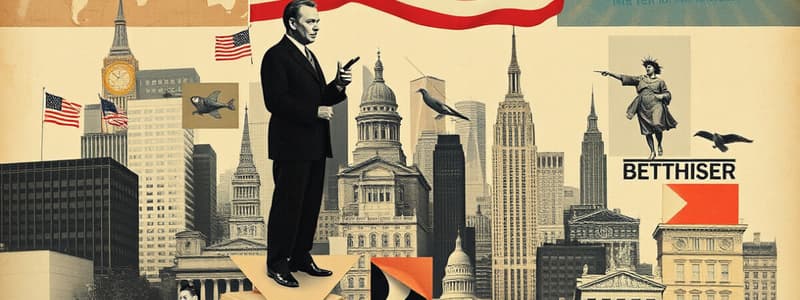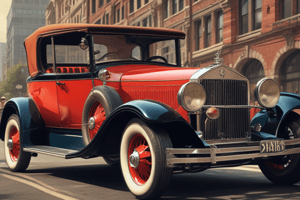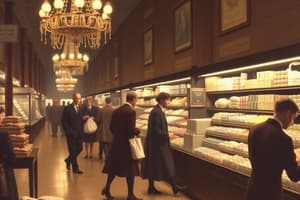Podcast
Questions and Answers
After the war, the American economy enjoyed?
After the war, the American economy enjoyed?
remarkable growth
_________________ came into widespread use during these years, transforming Americans' daily lives.
_________________ came into widespread use during these years, transforming Americans' daily lives.
Numerous innovations
The reduction in home inequality stemmed from federal tax policy that placed a ________________.
The reduction in home inequality stemmed from federal tax policy that placed a ________________.
70 percent tax rate on the richest Americans
Tax loopholes ________________.
Tax loopholes ________________.
The Cold War fueled industrial production and promoted a redistribution of the nation's?
The Cold War fueled industrial production and promoted a redistribution of the nation's?
Since the 1950s, the American economy has shifted away from?
Since the 1950s, the American economy has shifted away from?
The number of farms has ______________ since the 1950s, but farm production has ______________.
The number of farms has ______________ since the 1950s, but farm production has ______________.
The center of gravity of American farming shifted decisively to?
The center of gravity of American farming shifted decisively to?
The main engines of economic growth during the 1950s were?
The main engines of economic growth during the 1950s were?
The dream of ____________ came within reach of most Americans.
The dream of ____________ came within reach of most Americans.
Levittown is described as?
Levittown is described as?
California became the most prominent symbol of?
California became the most prominent symbol of?
Western cities were decentralized clusters of?
Western cities were decentralized clusters of?
In a consumer culture, the measure of freedom became the ability to?
In a consumer culture, the measure of freedom became the ability to?
Americans became comfortable living in never-ending debt, once seen as?
Americans became comfortable living in never-ending debt, once seen as?
Consumer culture demonstrated the superiority of?
Consumer culture demonstrated the superiority of?
Television replaced newspapers as the ________________________ about public events and provided
Television replaced newspapers as the ________________________ about public events and provided
TV avoided controversy and projected?
TV avoided controversy and projected?
Television also became?
Television also became?
A defining feature of American identity, mass consumption was?
A defining feature of American identity, mass consumption was?
Along with a home and television set, the car became part of what sociologists called?
Along with a home and television set, the car became part of what sociologists called?
Auto manufacturers and oil companies vaulted to?
Auto manufacturers and oil companies vaulted to?
The _____________________ transformed the nation's daily life.
The _____________________ transformed the nation's daily life.
After __________, women lost most of the industrial jobs they had performed during the war.
After __________, women lost most of the industrial jobs they had performed during the war.
By the mid-1950s women were working again, but?
By the mid-1950s women were working again, but?
Women were expected to?
Women were expected to?
Baby Boom refers to?
Baby Boom refers to?
The ___________ also became a weapon in the Cold War.
The ___________ also became a weapon in the Cold War.
________________ seemed to have disappeared from American life.
________________ seemed to have disappeared from American life.
The suburbs remained?
The suburbs remained?
During the postwar suburban boom, federal agencies continued to __________________________________, thereby financing housing segregation.
During the postwar suburban boom, federal agencies continued to __________________________________, thereby financing housing segregation.
A housing act passed by Congress in 1949 authorized _____________________________ in order to provide a "decent home for every American family."
A housing act passed by Congress in 1949 authorized _____________________________ in order to provide a "decent home for every American family."
Suburbanization hardened ___________________ in American life.
Suburbanization hardened ___________________ in American life.
______________ whites left the cities for the suburbs while ___________ blacks moved into the cities.
______________ whites left the cities for the suburbs while ___________ blacks moved into the cities.
Flashcards are hidden until you start studying
Study Notes
Post-War American Economy
- After World War II, the American economy experienced remarkable growth.
- Numerous innovations significantly transformed daily life in America.
- Federal tax policy implemented a 70 percent tax rate on the wealthiest, which has since decreased to 43 percent due to loopholes.
Cold War Impact
- The Cold War spurred industrial production and redistributed population and economic resources across the nation.
- Since the 1950s, there has been a notable shift away from manufacturing toward other sectors.
Agriculture Changes
- The number of farms decreased since the 1950s; however, farm production increased.
- The center of American farming has shifted predominantly to Texas, Arizona, and California.
Economic Growth Engines
- Key drivers of economic growth in the 1950s included residential construction and consumer goods spending.
- The aspiration for homeownership became accessible to most Americans.
Suburban Expansion
- Levittown, a New York suburb, pioneered mass home construction techniques post-war.
- California emerged as a leading symbol of the suburban boom.
Lifestyle and Consumer Culture
- Western cities developed as decentralized clusters of single-family homes and businesses linked by highways.
- Consumer culture defined freedom as the ability to satisfy market desires, with increasing comfort in living in debt.
- Mass consumption was promoted as a patriotic act during the Cold War, portraying the American way of life as superior to communism.
Television's Role
- Television replaced newspapers as the primary source of public information, catering to a shared cultural experience across diverse regions.
- It avoided controversy, presenting an idealized vision of middle-class life and became a powerful advertising platform.
Societal Changes and Expectations for Women
- Following 1945, women lost many industrial jobs gained during the war; by the mid-1950s, their work dynamics had shifted.
- The societal expectation for women centered around marriage, motherhood, and maintaining a home.
- The Baby Boom generation, a larger than expected group born after WWII, influenced family dynamics.
Racial and Gender Dynamics
- Feminism noticeably receded from American social visibility during this period.
- Suburbs remained largely segregated, supported by federal policies that insured mortgages excluding nonwhite buyers.
- In the postwar suburban boom, the federal government financed housing that reinforced segregation, with millions of whites moving to suburbs while many blacks relocated to cities.
Housing Initiatives
- The Housing Act of 1949 authorized the construction of over 800,000 public housing units to ensure decent homes for families.
- Suburbanization entrenched racial divisions, significantly impacting American society.
Studying That Suits You
Use AI to generate personalized quizzes and flashcards to suit your learning preferences.




